Internal Database
Built-in database authentication uses EMQX built-in Mnesia database to store the client's Clientid/Username and password, and supports management of authentication data through HTTP API.
The built-in database authentication does not rely on external data sources and is simple and lightweight enough to use.
Create Module
Open EMQX Dashboard, click the "Modules" tab on the left, and choose to add:

Click "Select", and then select the built-in database authentication module.
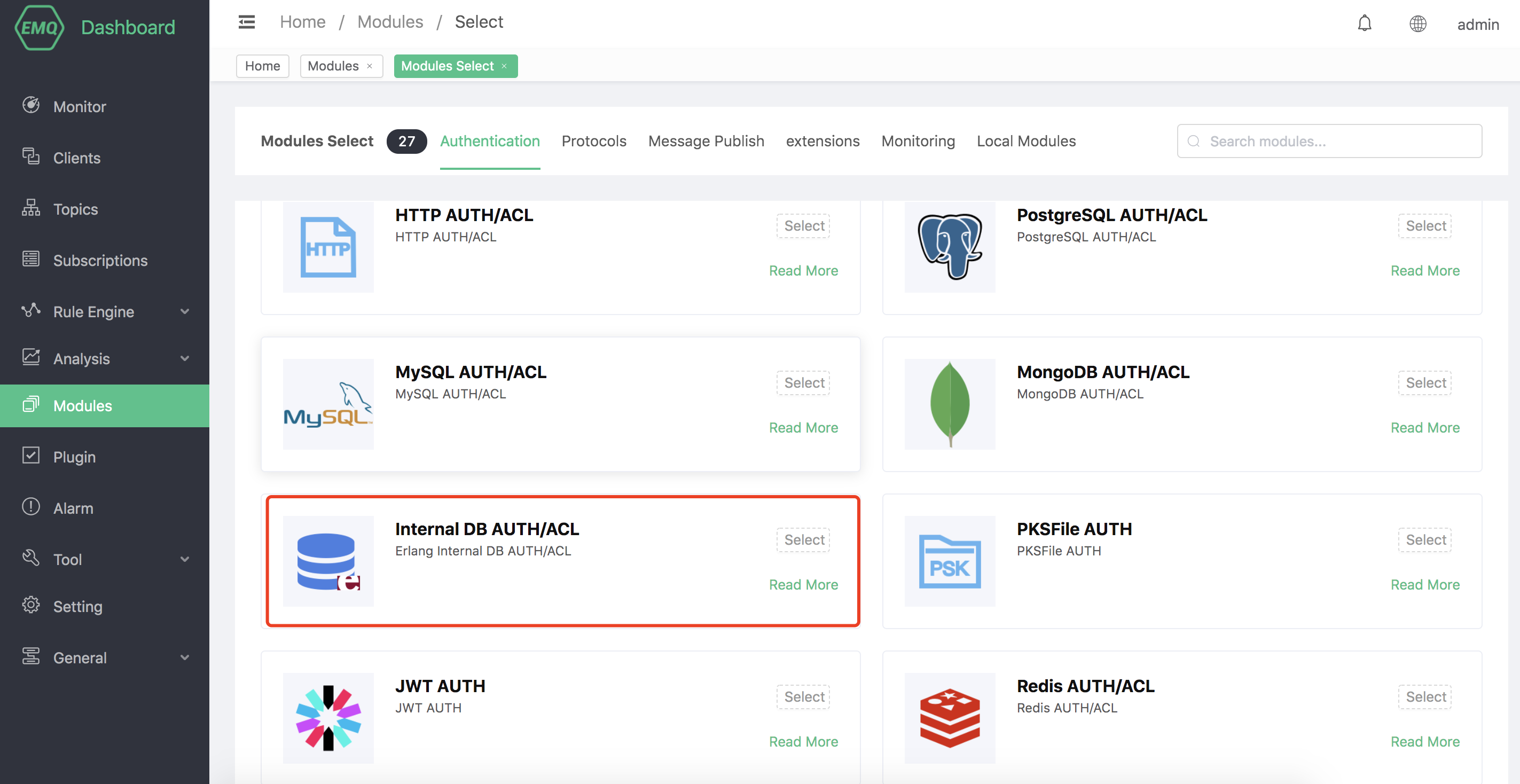
Configure related parameters.
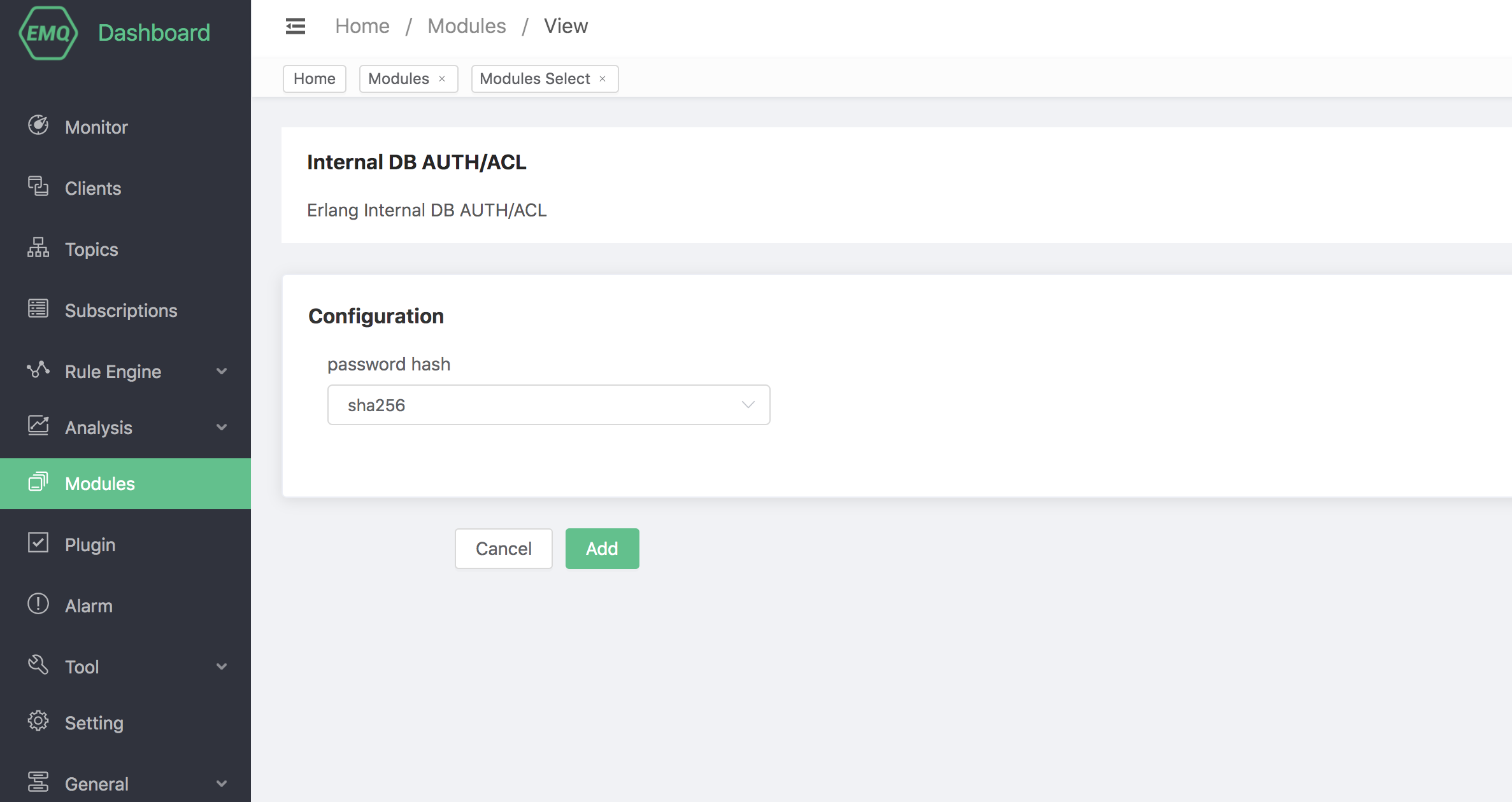
Finally, click the "Add" button to add the module successfully.
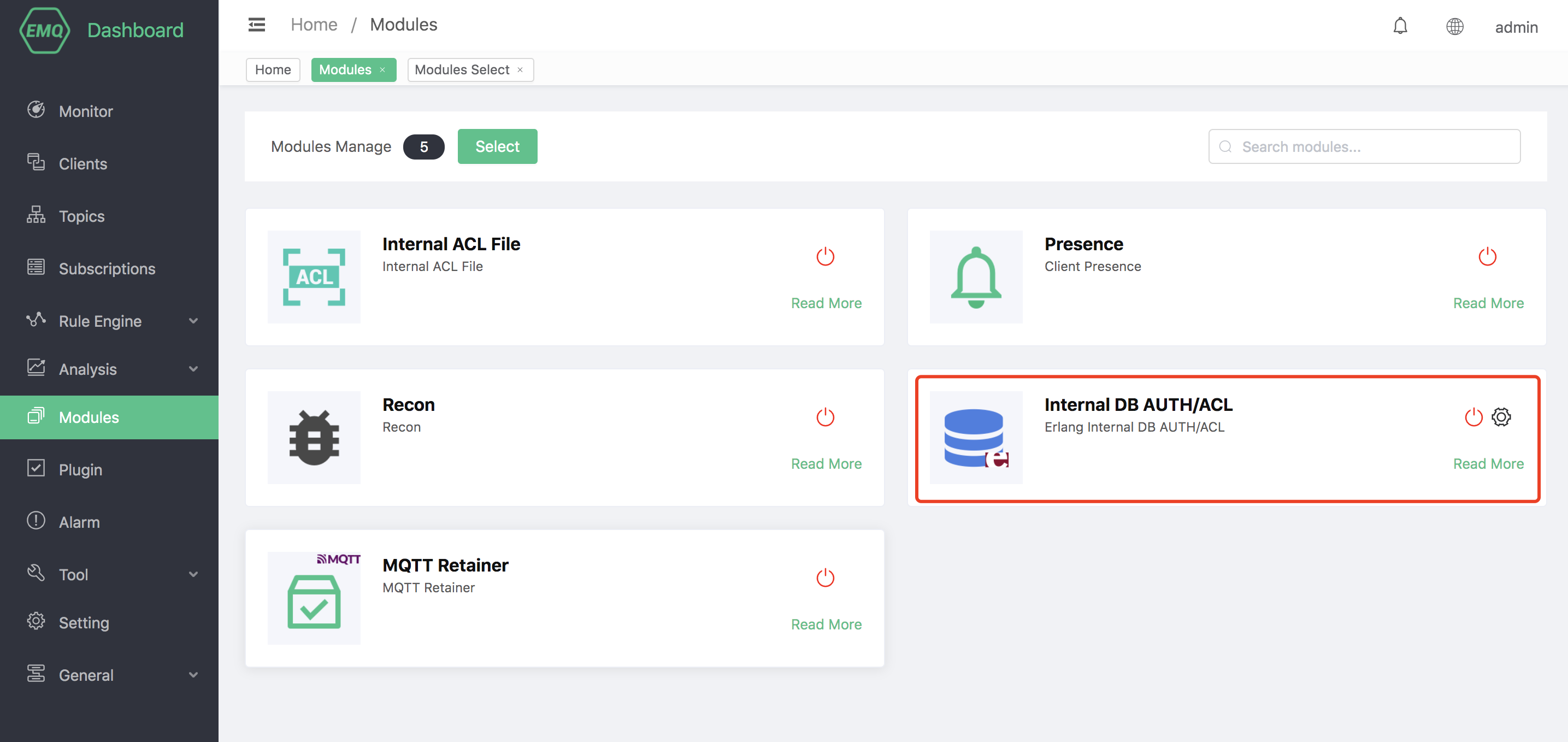
Manage Data
The built-in database can manage authentication and access control data through the Dashboard.

Authentication Data
The authentication data can be managed through the Dashboard.
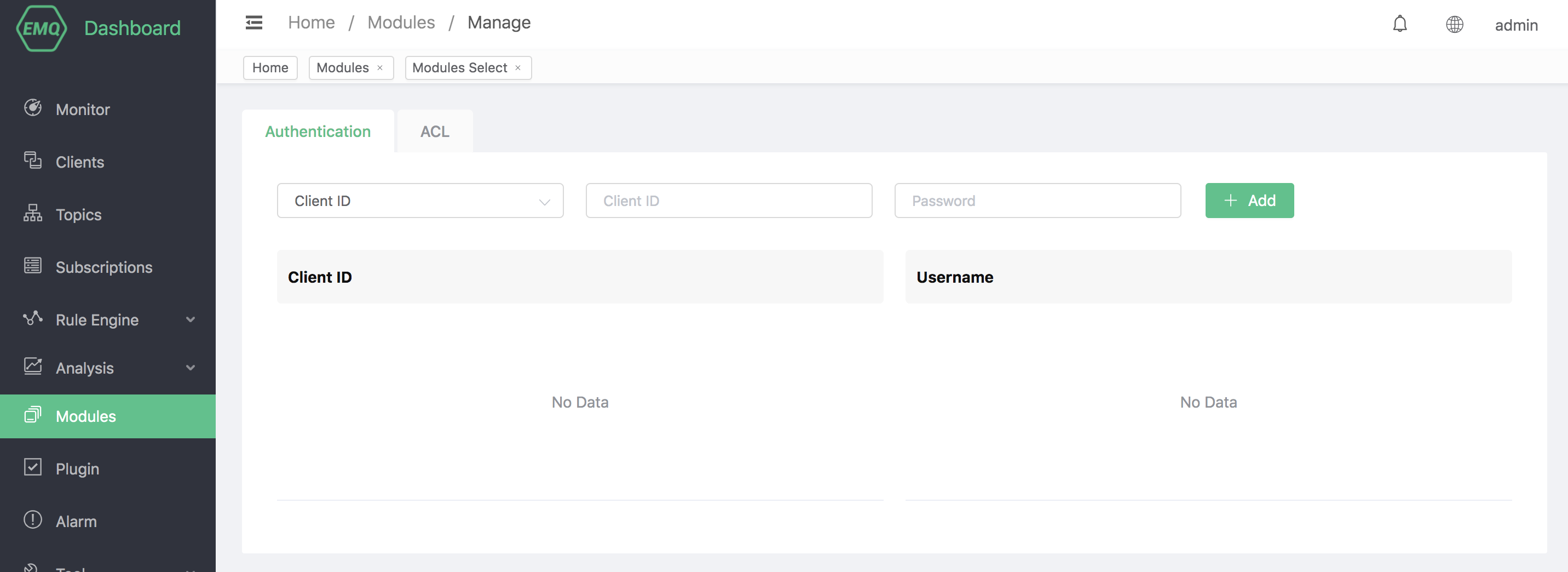
When the client connects to EMQX, the built-in database authentication will obtain the Clientid and Username in the CONNENT message, and then match the password recorded in the database. Once the match is successful, the authentication is successful.
Access Control Data
Access control data can be managed through the Dashboard.
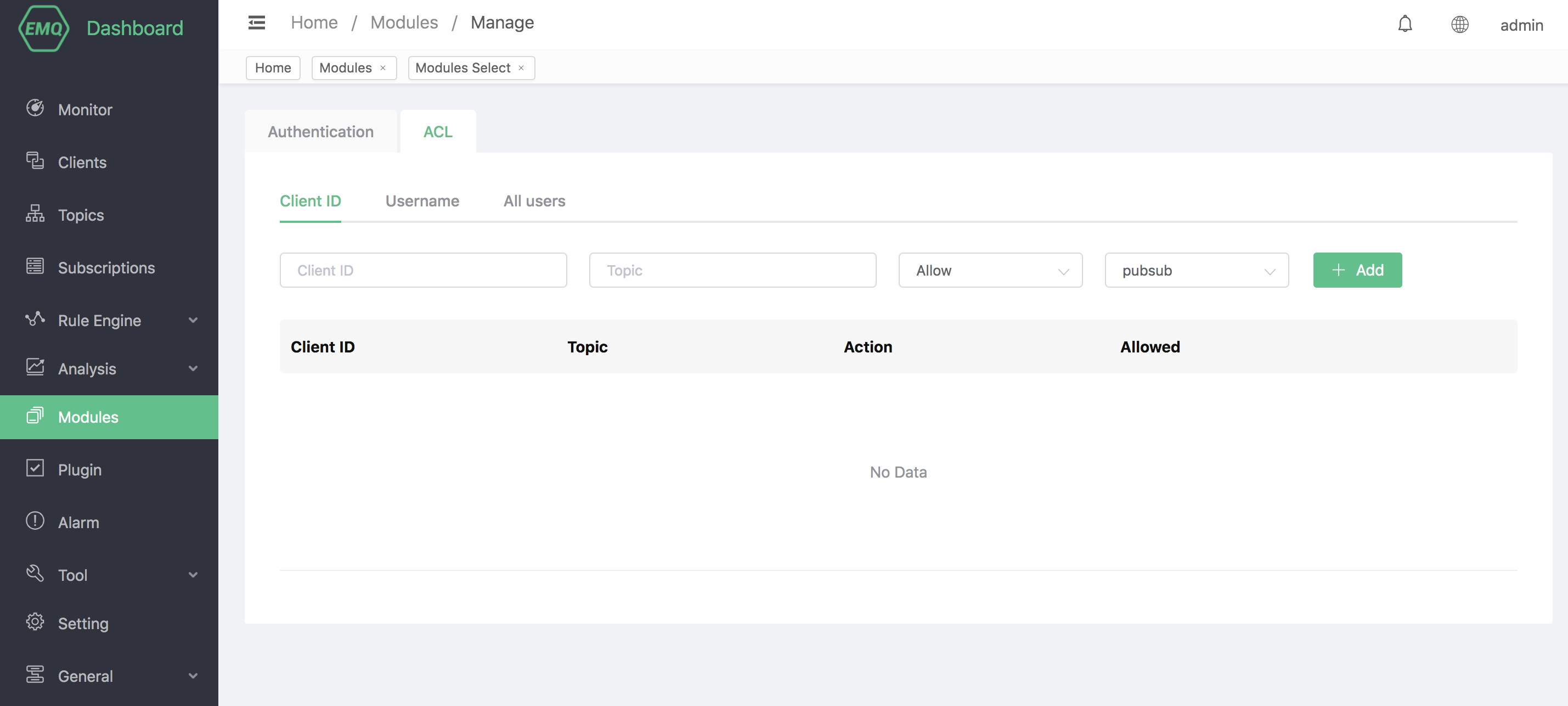
When the client publishes, subscribes, or unsubscribes to EMQX, the access control can allow or deny the operation according to the rules set in advance in the built-in database.
Set with HTTP API
The built-in database authentication and access control also support HTTP API operations.
Authentication
EMQX leverages its internal Mnesia database for authentication, eliminating reliance on external resources. This database stores Client IDs, usernames, and passwords, which users can efficiently manage through HTTP APIs.
POST api/v4/auth_clientid
To create authentication rules based on Client ID.
Parameters (json):
| Name | Type | Required | Description |
|---|---|---|---|
| clientid | String | True | Client ID |
| password | String | True | Password |
Success Response Body (JSON):
| Name | Type | Description |
|---|---|---|
| code | Integer | 0 |
Examples
## Request
curl -i \
--basic \
-u admin:public \
-X POST \
-d '{"clientid": "emqx_c", "password": "emqx_p"}' \
http://localhost:8081/api/v4/auth_clientid
## Return
{"code":0}POST api/v4/auth_username
To create authentication rules based on Username.
Parameters (json):
| Name | Type | Required | Description |
|---|---|---|---|
| username | String | True | Username |
| password | String | True | Password |
Success Response Body (JSON):
| Name | Type | Description |
|---|---|---|
| code | Integer | 0 |
Examples
## Request
curl -i \
--basic \
-u admin:public \
-X POST \
-d '{"username": "emqx_u", "password": "emqx_p"}' \
http://localhost:8081/api/v4/auth_username
## Return
{"code":0}POST api/v4/auth_clientid
To create authentication rules based on Client ID in batch.
Path Parameters: no
Parameters (json):
| Name | Type | Required | Description |
|---|---|---|---|
| [].clientid | String | True | Client ID |
| [].password | String | True | Password |
Success Response Body (JSON):
| Name | Type | Description |
|---|---|---|
| code | Integer | 0 |
| data | Object |
Examples
## Request
curl -i \
--basic \
-u admin:public \
-X POST \
-d '[{"clientid": "emqx_c_1", "password": "emqx_p"}, {"clientid": "emqx_c_2", "password": "emqx_p"}]' \
http://localhost:8081/api/v4/auth_clientid
## Return
{
"data":{
"emqx_c_2":"ok",
"emqx_c_1":"ok"
},
"code":0
}POST api/v4/auth_username
To create authentication rules based on Username in batch.
Path Parameters: no
Parameters (json):
| Name | Type | Required | Description |
|---|---|---|---|
| [].username | String | True | Username |
| [].password | String | True | Password |
Success Response Body (JSON):
| Name | Type | Description |
|---|---|---|
| code | Integer | 0 |
| data | Object |
Examples
## Request
curl -i \
--basic \
-u admin:public \
-X POST \
-d '[{"username": "emqx_u_1", "password": "emqx_p"}, {"username": "emqx_u_2", "password": "emqx_p"}]' \
http://localhost:8081/api/v4/auth_username
## Return
{
"data":{
"emqx_u_2":"ok",
"emqx_u_1":"ok"
},
"code":0
}GET api/v4/auth_clientid
To view the added authentication data.
Query String Parameters:
Fuzzy query can be performed based on the clientID.
| Name | Type | Required | Description |
|---|---|---|---|
| _like_clientid | String | False | Fuzzy queries are supported for Client IDs. |
Success Response Body (JSON):
| Name | Type | Description |
|---|---|---|
| code | Integer | 0 |
| meta | Object | Rule object |
| data | Object | Rule object |
| - data.[].clientid | String | Client ID |
Example
## Return
$ curl -i \
--basic \
-u admin:public \
-X GET \
http://localhost:8081/api/v4/auth_clientid?_like_clientid=emqx
## Request
{
"meta":{
"page":1,
"limit":10,
"count":3
},
"data":[
{
"clientid":"emqx_c_1"
},
{
"clientid":"emqx_c_2"
},
{
"clientid":"emqx_c"
}
],
"code":0
}GET api/v4/auth_username
To view the added authentication data.
Query String Parameters: Fuzzy query can be performed based on the clientID.
| Name | Type | Required | Description |
|---|---|---|---|
| _like_username | String | False | Fuzzy queries are supported for Client user name. |
Success Response Body (JSON):
| Name | Type | Description |
|---|---|---|
| code | Integer | 0 |
| meta | Object | Rule object |
| data | Object | Rule object |
| - data.[].username | String | Client ID |
Example
## Return
curl -i \
--basic \
-u admin:public \
-X GET \
http://localhost:8081/api/v4/auth_username?_like_username=emqx
## Request
{
"meta":{
"page":1,
"limit":10,
"count":3
},
"data":[
{
"username":"emqx_u"
},
{
"username":"emqx_u_2"
},
{
"username":"emqx_u_1"
}
],
"code":0
}GET api/v4/auth_clientid/{clientid}
To get the details of the specific resource.
Path Parameters:
| Name | Type | Required | Description |
|---|---|---|---|
| clientid | String | True | Client ID |
Success Response Body (JSON):
| Name | Type | Description |
|---|---|---|
| code | Integer | 0 |
| data | Object | Rule object |
| - data.clientid | String | Client ID |
| - data.password | String | Note: The password returned here is the password encrypted using the hash specified in the configuration file. |
Example
## Request
curl -i \
--basic \
-u admin:public \
-X GET \
http://localhost:8081/api/v4/auth_clientid/emqx_c
## Return
{
"data":{
"password":"bb7bb456355aaeb55a4eb26ea286314fc360138720cfca2c852d4dfb8cd834",
"clientid":"emqx_c"
},
"code":0
}GET api/v4/auth_username/{username}
To get the details of the specific resource.
Path Parameters:
| Name | Type | Required | Description |
|---|---|---|---|
| username | String | True | Username |
Success Response Body (JSON):
| Name | Type | Description |
|---|---|---|
| code | Integer | 0 |
| data | Object | Rule object |
| - data.username | String | Username |
| - data.password | String | Note: The password returned here is the password encrypted using the hash specified in the configuration file. |
Example
## Request
curl -i \
--basic \
-u admin:public \
-X GET \
http://localhost:8081/api/v4/auth_username/emqx_u
## Return
{
"data":{
"password":"bb7bb456355aaeb55a4eb26ea286314fc360138720cfca2c852d4dfb8cd834",
"clientid":"emqx_u"
},
"code":0
}PUT api/v4/auth_clientid/{clientid}
To updated the already added authentication data.
Parameters (json):
| Name | Type | Required | Description |
|---|---|---|---|
| clientid | String | True | Client ID |
Parameters (json):
| Name | Type | Required | Description |
|---|---|---|---|
| password | String | True | Password |
Success Response Body (JSON):
| Name | Type | Description |
|---|---|---|
| code | Integer | 0 |
Examples
## Request
curl -i \
--basic \
-u admin:public \
-X PUT \
-d '{"password": "emqx_new_p"}' \
http://localhost:8081/api/v4/auth_clientid/emqx_c
## Return
{"code":0}PUT api/v4/auth_username/{username}
To updated the already added authentication data.
Parameters (json):
| Name | Type | Required | Description |
|---|---|---|---|
| username | String | True | Username |
Parameters (json):
| Name | Type | Required | Description |
|---|---|---|---|
| password | String | True | Password |
Success Response Body (JSON):
| Name | Type | Description |
|---|---|---|
| code | Integer | 0 |
Examples
## Request
curl -i \
--basic \
-u admin:public \
-X PUT \
-d '{"password": "emqx_new_p"}' \
http://localhost:8081/api/v4/auth_username/emqx_u
## Return
{"code":0}DELETE /api/v4/auth_clientid/{clientid}
To delete an authentication rule.
Path Parameters:
| Name | Type | Required | Description |
|---|---|---|---|
| clientid | String | True | Client ID |
Parameters: no
Success Response Body (JSON):
| Name | Type | Description |
|---|---|---|
| code | Integer | 0 |
Examples:
## Request
curl -i \
--basic \
-u admin:public \
-X Delete\
http://localhost:8081/api/v4/auth_clientid/emqx_c
## Return
{"code":0}DELETE /api/v4/auth_username/{username}
To delete an authentication rule.
Path Parameters:
| Name | Type | Required | Description |
|---|---|---|---|
| username | String | True | Username |
Parameters: no
Success Response Body (JSON):
| Name | Type | Description |
|---|---|---|
| code | Integer | 0 |
Examples:
## Request
curl -i \
--basic \
-u admin:public \
-X Delete\
http://localhost:8081/api/v4/auth_username/emqx_u
## Return
{"code":0}Mnesia Access Control
EMQX leverages its internal Mnesia database for storing and managing access control rules for easy integration with external device management systems.
POST api/v4/acl
To add ACL rule.
Clientid ACL
Parameters (json):
Name Type Required Description clientid String True Client ID topic String True Topic action sub/pub/pubsub True Action access allow/deny True Alllow or deny Success Response Body (JSON):
Name Type Description code Integer 0 data Object Rule object - data.clientid String Clientid - data.topic String Topic - data.action String Action - data.access String Alllow or deny Examples
shell## Request curl -i \ --basic \ -u admin:public \ -X POST \ -d '{"clientid":"emqx_c", "topic":"Topic/A", "action":"pub", "access": "allow"}' \ http://localhost:8081/api/v4/acl ## Return { "data":{ "topic":"Topic/A", "result":"ok", "clientid":"emqx_c", "action":"pub", "access":"allow" }, "code":0 }Username ACL
Parameters (json):
Name Type Required Description username String True Username topic String True Topic action sub/pub/pubsub True Action access allow/deny True Alllow or deny Success Response Body (JSON):
Name Type Description code Integer 0 data Object Rule object - data.username String Username - data.topic String Topic - data.action String Action - data.access String Alllow or deny Examples
shell## Request curl -i \ --basic \ -u admin:public \ -X POST \ -d '{"username":"emqx_u", "topic":"Topic/A", "action":"pub", "access": "allow"}' \ http://localhost:8081/api/v4/acl ## Return { "data":{ "topic":"Topic/A", "result":"ok", "username":"emqx_u", "action":"pub", "access":"allow" }, "code":0 }$all ACL
Parameters (json):
Name Type Required Description topic String True Topic action sub/pub/pubsub True Action access allow/deny True Allow or deny Success Response Body (JSON):
name type description code integer 0 data object Rule object - data.all string $all - data.topic string Topic - data.action string Action - data.access string Allow or deny Examples
shell## Request curl -i \ --basic \ -u admin:public \ -X POST \ -d '{"topic":"Topic/A", "action":"pub", "access": "allow"}' \ http://localhost:8081/api/v4/acl ## Return { "data":{ "topic":"Topic/A", "result":"ok", "all":"$all", "action":"pub", "access":"allow" }, "code":0 }
POST api/v4/acl
To add ACL rules in batch.
Parameters (json):
| Name | Type | Required | Description |
|---|---|---|---|
| [0].clientid | String | True | Clientid |
| [0].topic | String | True | Topic |
| [0].action | sub/pub/pubsub | True | Action |
| [0].access | allow/deny | True | Allow or deny |
| [1].username | String | True | Username |
| [1].topic | String | True | Topic |
| [1].action | sub/pub/pubsub | True | Action |
| [1].access | allow/deny | True | Allow or deny |
| [2].topic | String | True | Topic |
| [2].action | sub/pub/pubsub | True | Action |
| [2].access | allow/deny | True | Allow or deny |
Success Response Body (JSON):
| name | type | description |
|---|---|---|
| code | integer | 0 |
| data | object | Rule object |
| - data.[0].clientid | string | Client ID |
| - data.[0].topic | string | Topic |
| - data.[0].action | string | Action |
| - data.[0].access | string | Allow or deny |
| - data.[1].username | string | Username |
| - data.[1].topic | string | Topic |
| - data.[1].action | string | Action |
| - data.[1].access | string | Allow or deny |
| - data.[2].all | string | $all |
| - data.[2].topic | string | Topic |
| - data.[2].action | string | Action |
| - data.[2].access | string | Allow or deny |
Examples
## Request
curl -i \
--basic \
-u admin:public \
-X POST \
-d '[
{
"clientid":"emqx_c_1",
"topic":"Topic/A",
"action":"pub",
"access": "allow"
},
{
"username":"emqx_u_1",
"topic":"Topic/A",
"action":"sub",
"access": "allow"
},
{
"topic":"Topic/+",
"action":"pubsub",
"access": "deny"
}
]' \
http://localhost:8081/api/v4/auth_clientid
## Return
{
"data": [
{
"clientid":"emqx_c_1",
"topic":"Topic/A",
"action":"pub",
"access": "allow",
"result": "ok"
},
{
"username":"emqx_u_1",
"topic":"Topic/A",
"action":"pub",
"access": "allow"
"result": "ok"
},
{
"all": "$all",
"topic":"Topic/+",
"action":"pubsub",
"access": "deny"
},
],
"code": 0
}GET api/v4/acl/clientid
To viewed the already added ACL rules.
Query String Parameters:
Support multi-condition and fuzzy query.
| Name | Type | Required | Description |
|---|---|---|---|
| access | Enum | False | Allow or deny |
| action | Enum | False | Action Options: pub,sub,pubsub |
| topic | String | False | MQTT topic |
| _like_clientid | String | False | Fuzzy queries are supported for Client IDs. |
Success Response Body (JSON):
| Name | Type | Description |
|---|---|---|
| code | Integer | 0 |
| data | Object | Rule object |
| - data.[].clientid | String | Clientid |
| - data.[].topic | String | Topic |
| - data.[].action | Enum | Action: pub, sub,pubsub |
| - data.[].access | Enum | Allow or deny |
Examples
## Request
curl -i \
--basic \
-u admin:public \
-X GET \
http://localhost:8081/api/v4/acl/clientid
## Return
{
"meta": {
"page": 1,
"limit": 10,
"count": 1
},
"data": [
{
"clientid": "emqx_c",
"topic": "Topic/A",
"action": "pub",
"access": "allow"
},
{
"clientid": "emqx_c_1",
"topic": "Topic/A",
"action": "pub",
"access": "allow"
},
{
"clientid": "emqx_c_2",
"topic": "Topic/A",
"action": "pub",
"access": "allow"
}
],
"code": 0
}GET api/v4/acl/username
To view already added ACL rules. Query String Parameters:
Support multi-condition and fuzzy query.
| Name | Type | Required | Description |
|---|---|---|---|
| access | Enum | False | Allow or deny |
| action | Enum | False | Action Options: pub,sub,pubsub |
| topic | String | False | MQTT topic |
| _like_username | String | False | Fuzzy queries are supported for client user name. |
Success Response Body (JSON):
| Name | Type | Description |
|---|---|---|
| code | Integer | 0 |
| data | Object | Rule object |
| - data.[].username | String | Username |
| - data.[].topic | String | Topic |
| - data.[].action | Enum | Action: pub, sub,pubsub |
| - data.[].access | Enum | Allow or deny |
Examples
## Request
curl -i \
--basic \
-u admin:public \
-X GET \
http://localhost:8081/api/v4/acl/username
## Return
{
"meta": {
"page": 1,
"limit": 10,
"count": 1
},
"data": [
{
"clientid": "emqx_u",
"topic": "Topic/A",
"action": "pub",
"access": "allow"
},
{
"clientid": "emqx_u_1",
"topic": "Topic/A",
"action": "pub",
"access": "allow"
},
{
"clientid": "emqx_u_2",
"topic": "Topic/A",
"action": "pub",
"access": "allow"
}
],
"code": 0
}GET api/v4/acl/$all
To view the already added ACL rules.
Success Response Body (JSON):
| Name | Type | Description |
|---|---|---|
| code | Integer | 0 |
| data | Object | Rule object |
| - data.[].all | String | $all |
| - data.[].topic | String | Topic |
| - data.[].action | String | Action |
| - data.[].access | String | Allow or deny |
Examples
## Request
curl -i \
--basic \
-u admin:public \
-X GET \
http://localhost:8081/api/v4/acl/\$all
## Return
{
"meta": {
"page": 1,
"limit": 10,
"count": 1
},
"data": [
{
"all": "$all",
"topic": "Topic/A",
"action": "pub",
"access": "allow"
},
{
"all": "$all",
"topic": "Topic/+",
"action": "pubsub",
"access": "deny"
}
],
"code": 0
}GET /api/v4/acl/clientid/{clientid}
To view the specific ACL rule.
Path Parameters:
| Name | Type | Required | Description |
|---|---|---|---|
| clientid | String | True | ClientID |
Parameters: 无
Success Response Body (JSON):
| Name | Type | Description |
|---|---|---|
| code | Integer | 0 |
| data | object | Rule object |
| - data.clientid | string | ClientID |
| - data.topic | string | Topic |
| - data.action | string | Action |
| - data.access | string | Allow or deny |
Examples:
## Request
curl -i \
--basic \
-u admin:public \
-X GET \
http://localhost:8081/api/v4/acl/clientid/emqx_c
## Return
{
"data": {
"topic": "Topic/A",
"clientid": "emqx_c",
"allow": true,
"action": "pub"
},
"code": 0
}GET /api/v4/acl/username/{username}
查看指定的 ACL 规则。
Path Parameters:
| Name | Type | Required | Description |
|---|---|---|---|
| usernmae | String | True | Username |
Parameters: 无
Success response body (json):
| name | type | description |
|---|---|---|
| code | integer | 0 |
| data | object | Rule object |
| - data.username | string | Username |
| - data.topic | string | Topic |
| - data.action | string | Action |
| - data.access | string | Allow or deny |
Examples:
## Request
curl -i \
--basic \
-u admin:public \
-X GET \
http://localhost:8081/api/v4/acl/usernmae/emqx_u
## Return
{
"data": {
"topic": "Topic/A",
"username": "emqx_u",
"allow": true,
"action": "pub"
},
"code": 0
}DELETE /api/v4/acl/clientid/{clientid}/topic/{topic}
To delete the specfici ACL rule.
Path Parameters:
| Name | Type | Required | Description |
|---|---|---|---|
| clientid | String | True | ClientID |
| topic | String | True | Topic, may need to be encoded in UrlEncode |
Parameters: no
Success response body (json):
| name | type | description |
|---|---|---|
| code | integer | 0 |
Examples:
## Request
curl -i \
--basic \
-u admin:public \
-X DELETE \
http://localhost:8081/api/v4/acl/clientid/emqx_c/topic/Topic%2fA
## Return
{"code": 0}DELETE /api/v4/acl/username/{usernmae}/topic/{topic}
To delete the specfici ACL rule.
Path Parameters:
| Name | Type | Required | Description |
|---|---|---|---|
| username | String | True | Username |
| topic | String | True | Topic, may need to be encoded in UrlEncode |
Parameters: no
Success response body (json):
| name | type | description |
|---|---|---|
| code | integer | 0 |
Examples:
## Request
curl -i \
--basic \
-u admin:public \
-X DELETE \
http://localhost:8081/api/v4/acl/username/emqx_u/topic/Topic%2fA
## Return
{"code": 0}DELETE /api/v4/acl/all/$all/topic/{topic}
To delete the specfici ACL rule.
Path Parameters:
| Name | Type | Required | Description |
|---|---|---|---|
| topic | String | True | Topic, may need to be encoded in UrlEncode |
Parameters: no
Success response body (json):
| name | type | description |
|---|---|---|
| code | integer | 0 |
Examples:
## Request
curl -i \
--basic \
-u admin:public \
-X DELETE \
http://localhost:8081/api/v4/acl/all/\$all/topic/Topic%2fA
## Return
{"code": 0}CLI
The built-in database authentication/access control also comes equipped with the administrative command-line tool ./bin/emqx_ctl.
clientid Commands
The clientid commands can be used to query or manange the clientid authentication.
| Commands | Description |
|---|---|
clientid list | List clientid related authentication rules. |
clientid add <ClientID> <Password> | Add clientid related authentication rules. |
clientid update <ClientID> <NewPassword> | Update clientid related authentication rules. |
clientid del <ClientID> | Delete clientid related authentication rules. |
clientid list
List clientid related authentication rules.
$ ./bin/emqx_ctl clientid list
emqx_clientidclientid add <ClientID> <Password>
Add clientid related authentication rules.
./bin/emqx_ctl clientid add emqx_clientid password
okclientid update <ClientID> <NewPassword>
Update clientid related authentication rules.
$ ./bin/emqx_ctl clientid update emqx_clientid new_password
okclientid del <ClientID>
Delete clientid related authentication rules.
$ ./bin/emqx_ctl clientid del emqx_clientid
okuser Commands
The user commands can be used to query or manange the username authentication.
| Commands | 描述 |
|---|---|
user list | List username related authentication rules. |
user add <Username> <Password> | Add username related authentication rules. |
user update <Username> <NewPassword> | Update username related authentication rules. |
user del <Username> | Delete username related authentication rules. |
user list
List username related authentication rules.
$ ./bin/emqx_ctl user list
emqx_usernameuser add <Username> <Password>
Add username related authentication rules.
./bin/emqx_ctl user add emqx_username password
okuser update <Username> <NewPassword>
Update username related authentication rules.
$ ./bin/emqx_ctl user update emqx_username new_password
okuser del <Username>
Delete username related authentication rules.
$ ./bin/emqx_ctl user del emqx_username
okacl Commands
The act commands can be used to query or manange the access control related rules.
| Commands | Description |
|---|---|
acl list clientid | List clientid related access control rules. |
acl list username | List username related access control rules. |
acl list _all | List $all access control rules. |
acl show clientid <Clientid> | View clientid related access control rules. |
acl show username <Username> | View username related access control rules. |
acl aad clientid <Clientid> <Topic> <Action> <Access> | Add clientid related access control rules. |
acl add Username <Username> <Topic> <Action> <Access> | Add username related access control rules. |
acl add _all <Topic> <Action> <Access> | Add $all access control rules. |
acl del clientid <Clientid> <Topic> | Delete clientid related access control rules. |
acl del username <Username> <Topic> | Delete username related access control rules. |
acl del _all <Topic> | Delete $all access control rules. |
acl list clientid
List clientid related access control rules.
$ ./bin/emqx_ctl acl list clientid
Acl(clientid = <<"emqx_clientid">> topic = <<"Topic/A">> action = pub access = allow)acl list username
List username related access control rules.
$ ./bin/emqx_ctl acl list username
Acl(username = <<"emqx_username">> topic = <<"Topic/A">> action = pub access = allow)acl list _all
List $all access control rules.
$ ./bin/emqx_ctl acl list _all
Acl($all topic = <<"Topic/A">> action = pub access = allow)acl show clientid <Clientid>
View clientid related access control rules.
$ ./bin/emqx_ctl acl show clientid emqx_clientid
Acl(clientid = <<"emqx_clientid">> topic = <<"Topic/A">> action = pub access = allow)acl show username <Username>
View username related access control rules.
$ ./bin/emqx_ctl acl show username emqx_username
Acl(username = <<"emqx_username">> topic = <<"Topic/A">> action = pub access = allow)acl aad clientid <Clientid> <Topic> <Action> <Access>
Add clientid related access control rules.
$ ./bin/emqx_ctl acl add clientid emqx_clientid Topic/A pub allow
okacl aad username <Username> <Topic> <Action> <Access>
Add username related access control rules.
$ ./bin/emqx_ctl acl add username emqx_username Topic/A pub allow
okacl aad _all <Topic> <Action> <Access>
Add $all access control rules.
$ ./bin/emqx_ctl acl add _all Topic/A pub allow
okacl del clientid <Clientid> <Topic>
Delete clientid related access control rules.
$ ./bin/emqx_ctl acl del clientid emqx_clientid Topic/A
okacl del username <Username> <Topic>
Delete username related access control rules.
$ ./bin/emqx_ctl acl del username emqx_username Topic/A
okacl del _all <Topic
Delete $all access control rules.
$ ./bin/emqx_ctl acl del _all Topic/A
ok